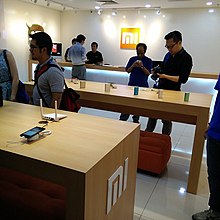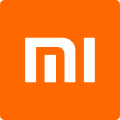Xiaomi
Xiaomi Inc. ([ɕjǎu.mì] ( listen); Chinese: 小米) is a Chinese electronics and software company headquartered in Beijing. Xiaomi designs, develops, and sells smartphones,mobile apps, laptops and related consumer electronics.[2]
listen); Chinese: 小米) is a Chinese electronics and software company headquartered in Beijing. Xiaomi designs, develops, and sells smartphones,mobile apps, laptops and related consumer electronics.[2]
Xiaomi released its first smartphone in August 2011 and has rapidly gained market share in China to become China's largest smartphone company in 2014.[3] As of 2017 Xiaomi was the world's 5th largest smartphone company.[4][5] As of the start of Q2 of 2018, Xiaomi has now become the world's 4th largest smartphone manufacturer.[6][7] Xiaomi has expanded into developing a wider range of consumer electronics, including a smart home (IoT) device ecosystem.[8][9][10][11]
Xiaomi has 15,000 employees[12] in China,India, Malaysia,[13] Singapore and is expanding to other countries such asIndonesia, the Philippines and South Africa.[14][15] Lei Jun, the founder and CEO, has an estimated net worth of US$6.8 billion. He is China's 24th richest person in 2017. Xiaomi is the world's 4th most valuable technology start-up after it received US$1.1 billion funding from investors, making Xiaomi's valuation more than US$46 billion.[16]
Etymology
Xiaomi is the Chinese word for "millet".[17] In 2011 its CEO Lei Jun suggested there are more meanings than just the "millet and rice."[18] He linked the "Xiao" part to theBuddhist concept that "a single grain of rice of a Buddhist is as great as a mountain," suggesting Xiaomi wants to work from the little things, instead of starting by striving for perfection,[18] while "mi" is an acronym for Mobile Internet and also Mission Impossible, referring to the obstacles encountered in starting the company.[18][19] He also stated that he thinks the name is cute.[18] In 2012 Lei Jun said that the name is about revolution and being able to bring innovation into a new area.[20] Xiaomi's new 'Rifle' processor[21] has given weight to several sources linking the latter meaning to the Communist Party of China's "millet and rifle" (小米加步枪) revolutionary idiom[22][23] during the Second Sino-Japanese War.[24][25][26][27]
History
2010
On 6 April 2010 Xiaomi was co-founded by Lei Jun and seven partners:
- Lin Bin, vice president of the Google ChinaInstitute of Engineering
- Dr Zhou Guangping, senior director of the Motorola Beijing R&D center
- Liu De, department head of industrial design at the University of Science and Technology Beijing
- Li Wanqiang, general manager of KingsoftDictionary
- Wong Kong-Kat, principal development manager
- Hong Feng, senior product manager for Google China
In the first round of funding, institutional investors included Temasek Holdings, IDG Capital, Qiming Venture Partners[28] andQualcomm.[29]
On 16 August 2010, Xiaomi officially launched its first Android-based firmware MIUI.[30] It resembles Samsung's TouchWiz and Apple's iOS.
2011
The Xiaomi Mi 1 smartphone was announced in August 2011. It has Xiaomi's MIUI firmware. The device could also be installed with stock Android.[31]
2012
2013
On 5 September 2013, Xiaomi CEO Lei Junannounced plans to launch an Android-based 47-inch 3D-capable Smart TV,[34] which will be assembled by Sony TV manufacturer Wistron Corporation of Taiwan.[35] The company explained the choice as to take advantage of Wistron's skill as a supplier of Sony.[36]
By October 2013 Xiaomi was the fifth-most-used smartphone brand in China.[39]
In 2013 it sold 18.7 million smartphones.[40]
2014
In 2014 Xiaomi announced its expansion outside China, with their first international headquarters in Singapore. Future product launches and activities in the region will be set up there.[41] Following Singapore, the company opened in Malaysia, Philippines and India,[42] and plans to enter Indonesia, Thailand, Russia, Turkey, Brazil and Mexico in the following months.[43]
On 21 February 2014 Xiaomi's Redmi and Mi 3 phone were released in Singapore.[44][45] TheXiaomi Mi 3 batches were sold out within 2 minutes of the opening day sale in Singapore.[46]
In April 2014 Xiaomi purchased the Internet domain mi.com for a record US$3.6 million, the most expensive domain name ever bought in China, replacing xiaomi.com as the official Xiaomi domain.[48]
In November 2013 Xiaomi said it would invest US$1 billion in television content building.[49]
In December 2014 Xiaomi completed a round of equity financing led by Hong Kong-based technology fund All-Stars Investment Limited, a fund run by former Morgan Stanley analyst Richard Ji[50][51] raising over US$1 billion, with a valuation of more than US$45 billion making it one of the most valuable private technology companies in the world.[52]
The company sold over 60 million smartphones in 2014.[53]
2015
In April 2015 Xiaomi announced it would make its Mi devices available through two of India's major e-commerce sites and through offline retailers for the first time.[54]
On 23 April 2015, Xiaomi CEO Lei Jun and VP Hugo Barra came together to announce a new smartphone named Mi 4i in India, the first phone to be launched in India before any other country. The Xiaomi Mi Band was also launched in the same event.
On 30 June 2015, Xiaomi announced its expansion into Brazil with the launch of locally manufactured Redmi 2; it is the first time the company assembled a smartphone outside of China.[57]
2016
On 24 February 2016, Xiaomi launched the Mi 5 smartphone.
On 9 March 2016, Xiaomi launched its Redmi Note 3 in India. It was a groundbreaking smartphone at the time in the budget segment, and was well received by Indian customers. It made record sales on the year, and Xiaomi brand name continued to grow.
Shortly after starting operations in Brazil the company left the country in the second half of 2016.[60]
In July 2016 Chinese artists as Liu Shishi, Wu Xiubo and Liu Haoran became the first ambassadors of Xiaomi's Redmi series inChina.[61]
In August 2016 Xiaomi entered Bangladesh via Solar Electro Bangladesh Limited.[62]
In September 2016 Xiaomi's cell phones became officially available in the European Union through their partnership with ABC Data.[63]
2017
On 20 February, Xiaomi officially launched in Pakistan and brought its Mi and RedMi Note lineup to the country.[64]
On 19 April, Xiaomi launched Mi 6, its flagship phone at the time.
In May, Xiaomi opened two MI Home stores; one in Bangalore (India) and one in Bangladesh. It is the first of several planned for the region.[65]
On 25 May, Xiaomi released Mi Max 2.
On 26 August, new MIUI v9 alongside Mi 5x has been released.[66]
On 31 August, Xiaomi opened its first flagship Mi Store in Faisalabad, Pakistan.[67]
On 5 September Xiaomi released Mi A1, which is the first Android One smartphone under the slogan: Created by Xiaomi, Powered by Google. In the event key note Xiaomi stated they started working with Google for the Mi A1 Android One smartphone almost six months ago. An alternate version of the phone is also available with MIUI and is known as MI 5X.
On 7 November, Xiaomi started operating in Spain, making available the Mi A1 and Mi Mix 2 smartphones.[70]
In Q3 2017, Xiaomi overtook Samsung to become the number one smartphone brand in India. Xiaomi has sold 9.2 million units during this period.[71]
2018
On 20 February, Xiaomi opened their first Mi Store in the Philippines.[72]
In March 2018, at China's annual legislative session in Beijing, Xiaomi CEO Lei Jun announced that Xiaomi has "always been considering entering the US market" and will launch in the US smartphone market by late 2018 or early 2019. Xiaomi already sells assorted items in the US such as power banksand Bluetooth speakers.[73]
On 3 April 2018, Xiaomi launched the Mix 2S model which is a successor of Mix 2.[74]
On 25 April 2018, Xiaomi launched the Mi 6X, a successor of Mi 5X.
On 22 May 2018, Xiaomi will open, in Paris, its first French store.[75]
On May 3, 2018, Xiaomi filled to go public on the Hong Kong Stock Exchange and aims to raise $10 billion in IPO which is expected to be the world’s biggest IPO raise since 2014.[76]
On May 3. 2018, Xiaomi announced in partnership with 3 (telecommunications) to sell smartphones in the United Kingdom, Ireland, Austria, Denmark, and Sweden[77]
Business Model

A Xiaomi Exclusive Service Centre for customer support in Kuala Lumpur.
Lei Jun, Xiaomi's CEO, said that the company prices the phone almost at bill-of-materialprices,[79][80] without compromising the component quality and performance compared to other premium smartphones.[81]It also profits by selling phone-related peripheral devices, smart home products, apps, online videos and themes.[82][83]According to Xiaomi's Hugo Barra in 2014, the company sees hardware sales as a means of delivering software and services in the long term, "We are an Internet and a software company much more than a hardware company."[84] However, financial data available at the time indicated that this is either wishful thinking or plans for the far future: 94% of the company's revenue came from mobile phone sales, an even higher proportion than Apple.[81]
At first, to reduce overhead costs, Xiaomi did not own any physical stores, selling exclusively from its online store. In recent years, they have opened 54 brick and mortar stores to combat the strategies of other low-cost competitors in Chinese markets. It also did away with traditional advertising and relies on social networking services and word-of-mouth to publicise its products.[85]
By keeping a tight control over its stock, Xiaomi is able to place cheaper batch orders as demand dictates. Limited availability flash sales ensure that supply never outstrips demand and helps promote its products. In contrast traditional OEMs incur large upfront productions costs, which must be recouped by selling prices, in order to ship phones, some of which may not sell, out to retailers all around the world.[86]
Xiaomi say that they listen closely to customer feedback, having them test out upcoming features themselves, and building an extensive online community.[87] Lei Jun described it this way, "When I was withKingsoft, I had the opportunity to work withNokia and Motorola, two mobile phone giants of their time. One day, I pointed out to their R&D boss, some inadequacies. After that, they merely acknowledged my input, but never acted upon what I had said. So I thought to myself, if I make a phone, you can tell me anything you wish for it or what's wrong. If it is justifiable, we will work on it immediately. I'll give you an update every week and you may even see your wishes come true within a week."[81][88] In practice, Xiaomi's product managers spend a lot of time browsing through the company's user forums. Once a suggestion is picked up, it is quickly transferred to the engineers. Therefore, features can turn from mere concept to shipping products within a week. The company then ships a new batch of phones out every week on Tuesday at noon Beijing time, containing the new software builds and possible minor hardware tweaks. Xiaomi calls this process "design as you build."[89]
According to the patent landscape report[90]published in December 2016 by a patent research and analytics firm GreyB Services,[91]Xiaomi owns 6989 patents with more than 90% of patents filed/acquired after 2012. The surge in number of patents was due to aggressive patent acquisition/licensing deals with many companies including Broadcom,Intel, and Microsoft. The patent acquisition was a strategic move by Xiaomi to strengthen its weak patent portfolio aligned with its global expansion plan to create a defence against patent lawsuits.

Comments
Post a Comment